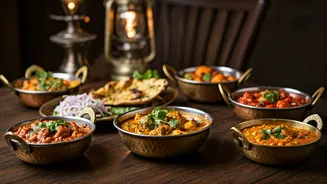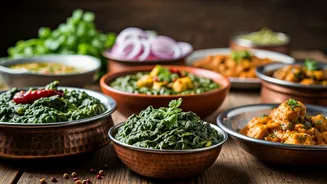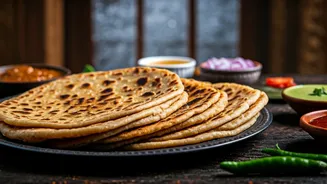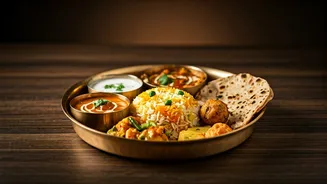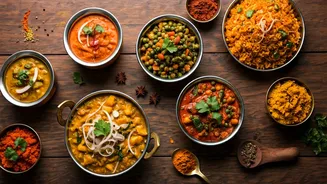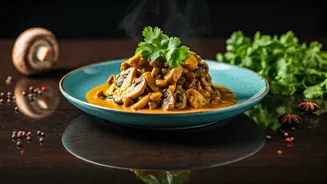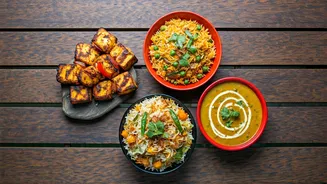Culinary Epic's Echo
The Mahabharata, an ancient Indian epic, is not just a tale of war and dharma; it also offers a glimpse into the culinary habits of the time. The food
served during that era reflected the values and lifestyle of the people. This article aims to explore this lesser-known aspect, providing recipes inspired by the Mahabharata. These dishes, adapted for modern kitchens, offer a blend of history and flavor. The goal is to make the experience enjoyable and accessible, allowing everyone to savor the tastes of the past. These recipes are more than just cooking instructions; they are pathways into understanding the rich cultural heritage, providing a unique culinary experience. The dishes are based on available information about the ingredients and cooking techniques employed during the Mahabharata period, while ensuring simplicity and ease of preparation.
The Simple Saag
Green leafy vegetables, known as 'saag', played a significant role in the diet of the people in those times. This recipe offers a basic saag preparation. It typically involves cooking spinach or mustard greens (sarson ka saag) with minimal spices to preserve the natural flavors of the greens. The recipe begins by gently sauteing the greens with a hint of garlic, ginger, and green chilies. The cooked greens are then blended to retain a smooth consistency. The preparation ensures the flavors are vibrant, reflecting the basic culinary practices. The dish can be enhanced with a tempering of cumin seeds and a dash of ghee, adding richness. Serving the saag with hot roti or rice makes it a complete meal, embodying the simplicity and nutritional value that characterized the era.
Lentil Power Dish
Lentils, or 'dal', were a crucial element of the Mahabharata period diet, providing essential protein and nutrients. This recipe suggests a simple lentil preparation, likely made with readily available lentils such as masoor or moong dal. The lentil dish begins with a simple process of boiling the lentils until they achieve a soft texture. Spices like turmeric, cumin, and coriander are added to enhance the flavor. Tempering with asafoetida (hing) and mustard seeds gives a distinct aroma and taste. For a variation, adding finely chopped tomatoes and onions can be done to add more flavor. This basic recipe showcases the essential role lentils played, highlighting the focus on wholesome meals. The simplicity in preparation, combined with the dish's nutritional value, highlights the ancient approach towards health.
The Versatile Rice
Rice was another staple in the Mahabharata era, serving as a versatile element in various dishes. This recipe offers a straightforward method to cook perfect rice. The process involves washing the rice thoroughly to eliminate excess starch. The rice is then cooked with water, ensuring a perfect consistency. A small amount of salt can be added to enhance the taste. Cooking the rice till the water is completely absorbed is important to attain the right texture. The cooked rice can be the base for various preparations. The simple preparation mirrors the traditional ways in which the common people had rice. Whether consumed as plain rice or combined with other dishes, this recipe underscores the importance of rice in the meals, providing energy and sustenance.
Refreshing Buttermilk Delight
Buttermilk, or 'chaas', held a significant place in the Mahabharata diet, functioning as a digestive aid and a refreshing beverage. This recipe gives a simple preparation of buttermilk, involving churning curd with water to reach the desired consistency. A pinch of salt and roasted cumin powder are added to enhance the flavor. For variety, fresh coriander leaves or a small piece of ginger can be incorporated to create a unique flavor profile. The recipe reflects a health-conscious approach to food. Buttermilk was essential, showcasing the people's understanding of the importance of hydration. This refreshing drink complements the heavier dishes, aiding digestion, providing a refreshing break from the richness of the main courses.
Sweet Endings: Kheer
Kheer, or rice pudding, served as a festive dessert. This recipe demonstrates the traditional preparation of kheer. The process involves slow cooking of rice with milk, ensuring the rice becomes soft and the milk thickens. Sugar or jaggery is added for sweetness, and cardamom powder adds aroma. Garnishing with dry fruits, such as almonds and cashews, adds taste and texture. This dessert reflects the desire for treats, showcasing the ability to blend simple ingredients to create something delightful. The sweetness and creamy texture of the kheer highlight the celebration of life, ending the culinary journey on a joyful note. This dessert offered a perfect closure to a meal, embodying the spirit of celebration and indulgence in the Mahabharata era.
